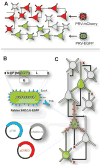Molecular genetics and imaging technologies for circuit-based neuroanatomy
- PMID: 19829369
- PMCID: PMC2884271
- DOI: 10.1038/nature08536
Molecular genetics and imaging technologies for circuit-based neuroanatomy
Abstract
Brain function emerges from the morphologies, spatial organization and patterns of connectivity established between diverse sets of neurons. Historically, the notion that neuronal structure predicts function stemmed from classic histological staining and neuronal tracing methods. Recent advances in molecular genetics and imaging technologies have begun to reveal previously unattainable details about patterns of functional circuit connectivity and the subcellular organization of synapses in the living brain. This sophisticated molecular and genetic 'toolbox', coupled with new methods in optical and electron microscopy, provides an expanding array of techniques for probing neural anatomy and function.
Figures


References
-
- Pfister H, Lichtman J, Reid C. The Connectome Project. 2009. < http://iic.harvard.edu/research/connectome>.
-
- Macagno ER, Levinthal C, Sobel I. Three-dimensional computer reconstruction of neurons and neuronal assemblies. Annu Rev Biophys Bioeng. 1979;8:323–351. - PubMed
-
- White JG, Southgate E, Thomson JN, Brenner S. The structure of the nervous system of the nematode Caenorhabditis elegans. Philos Trans R Soc Lond. 1986;314:1–314. - PubMed
-
- Ahmed B, Anderson JC, Martin KA, Nelson JC. Map of the synapses onto layer 4 basket cells of the primary visual cortex of the cat. J Comp Neurol. 1997;380:230–242. - PubMed
Publication types
MeSH terms
Grants and funding
LinkOut - more resources
Full Text Sources
Other Literature Sources

